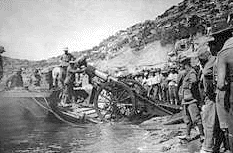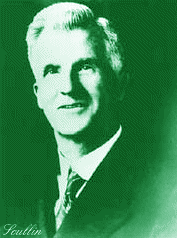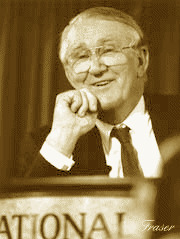|
AUSTRALIA
~
The Commonwealth ~
Central to the history of Australia
in the 20th century has been the development of both a national
government and a national culture. Commonwealth governments, led
by such architects of federation as Alfred
Deakin (1856-1919), quickly established a protective tariff to
foster internal development, designed procedures for setting
minimum wages in industry, and preserved the white immigration
policy.
 World
War I (1914-18), much more than federation itself, began the
transformation of Australian identity from that of six colonies to
a united nation. Responding to the allied call for troops,
Australia sent more than 330,000 volunteers, who took part in some
of the bloodiest battles. Suffering a casualty rate higher than
that of many other participants, Australia became increasingly
conscious of its contribution to the war effort. World
War I (1914-18), much more than federation itself, began the
transformation of Australian identity from that of six colonies to
a united nation. Responding to the allied call for troops,
Australia sent more than 330,000 volunteers, who took part in some
of the bloodiest battles. Suffering a casualty rate higher than
that of many other participants, Australia became increasingly
conscious of its contribution to the war effort.
At Gallipoli, an Australian and New
Zealand Army Corps tried in vain to launch a drive on the Turkish
forces in the Dardanelles. The date of the fateful landing, April
25, 1915, became equated with Australia's coming of age, and it
has remained the country's most significant day of public homage.
In 1915 William
M.("Billy") Hughes (1864-1952) became Prime Minister
and leader of the Labor Party. Representing Australia at councils
in London, Hughes personified Australian energies. When he failed
to carry the electorate in two attempts to supplement volunteers
with conscripted men, Hughes remained in power by forming the
Nationalist Party, much to the annoyance of his Labor colleagues.
He attended the Paris Peace Conference in 1919, acquiring German
New Guinea as a mandated territory and establishing Australia's
right to enter the League of Nations.
In the meantime, the war effort had
brought the country to a new level of prosperity, having
encouraged development of manufacturing industries and more
exports of foodstuffs, minerals, and wool. The powers designated
to the federal government in the constitution proved sufficient to
allow a strong central government.
After an internal backlash within
the Nationalist Party forced the retirement of Hughes in 1923,
Stanley
M. Bruce became Prime Minister. The Country Party, founded in
1919 as a patriotic, conservative movement to protect the
interests of farmers and graziers, joined the Nationalist
coalition, although it kept its own identity. The chief opponent
of the coalition was Labor, which had to redefine its social
policies.
To maintain wartime levels of
production and expansion the government sought to build up the
basic industries, but the depression of 1929 cut deeply into the
health of the Australian economy, increasing public and private
debts at a time of massive unemployment.
 Recovery
from the depression, led from 1929 to 1931 by
James
H. Scullin (1876-1953) and the Labor Party, was extremely
uneven. Disagreement on government policy broke Labor again in
1931, and for the rest of the 1930s, the United Australia Party,
composed of former Nationalists and disenchanted Laborites, held
the reins of power. It was led by Joseph
A. Lyons (1879-1939). Recovery
from the depression, led from 1929 to 1931 by
James
H. Scullin (1876-1953) and the Labor Party, was extremely
uneven. Disagreement on government policy broke Labor again in
1931, and for the rest of the 1930s, the United Australia Party,
composed of former Nationalists and disenchanted Laborites, held
the reins of power. It was led by Joseph
A. Lyons (1879-1939).
From its first assumption of
responsibility in foreign affairs, Australia had been guided by
its cultural and political ties with Britain. Emphasis was placed
on following Britain's leadership in solving the problems of the
depression. Chief among these was an attempt to redirect more
trade between Britain and the dominions. As early as the 1920s,
however, Japan and the U.S. were among Australia's best customers
for its wool.
When war came again in Europe in
1939, Australia dispatched its small armed forces to assist in
Britain's defence. After the Pacific war between Japan and the
U.S. broke out in 1941 and Britain was unable to provide
sufficient support for Australia's defence, the new Labor
government of John
Curtin (1885-1945) sought alliance with the U.S.
Until the liberation of the
Philippines, U.S. Gen. Douglas MacArthur and his staff used
Australia as a base for their operations. Although casualties were
lighter than in World War I, Australians were more psychologically
affected by the Second World War because of their fears of a
Japanese invasion. Both Darwin and Broome were bombed by the
Japanese and many Australian soldiers fought in the Pacific arena.
Again Australian industry was
transformed by the needs of war. The economy was redirected toward
manufacturing, and heavy industries ringed the capital cities.
Postwar development built further on the foundations established
during the war.
Prime Minister Curtin died in 1945,
but the new Labor government under Joseph
B. Chifley (1885-1951) strengthened Australia's relationship
with the U.S. in the ANZUS pact for mutual assistance (with New
Zealand as a third partner). As a charter member of the UN,
Australia also agreed to the decolonisation of the islands in the
Pacific, including the preparation of Papua-New Guinea for
independence (achieved in 1975).
In 1949 Robert
Menzies became Prime Minister, ushering in a long era of
political stability. During the war, the old United Australian
Party had disintegrated. In its stead arose the Liberal Party,
which attracted those who opposed Labor's internal policies. Like
its predecessor, it formed a Coalition with the Country Party (now
the National Party). Menzies, prime minister until 1966, gave
Australia centralised and personal leadership. He stressed the
sentimental linkage with the British crown but took more active
interest than his predecessors in Pacific and South Asian affairs.
Under the Colombo Plan, Asians began to study in Australian
institutions. By 1966 the White Australia policy was discarded,
and the entry of immigrants has since been based on criteria other
than race.
Australia fulfilled its commitment
to the Western alliance by fighting in the Korean War (1950-53),
participating in the Southeast Asia Treaty Organisation (SEATO)
from 1954 until its dissolution in 1977, and fighting in the
Vietnam War as an ally of the U.S. Meanwhile, Australia adjusted
its domestic and foreign policies to recognise its growing trade
ties with Japan.
 From
1966 to 1972, the Liberal Party provided several prime ministers
who sought to extend the Menzies era. In 1972, the Labor Party led
by Gough
Whitlam (1916- ) again came to power. Whitlam's plans for
increased social services, however, were in conflict with both the
traditional rights of the states and declining economic
prosperity; the Liberal-Country coalition was returned to power under
Malcolm
Fraser in 1975. He reinstated the policies followed by the
earlier Liberal Party governments. Fraser's Coalition survived the
1980 election with a much reduced majority. Shaken by defections
from Liberal Party ranks and by foreign trade scandals, Fraser
suffered a sharp defeat in the elections of March 1983. His Labor successor,
Bob
Hawke, sought to promote labour-management cooperation and
stimulate the economy. Labor retained its majorities in the
elections of December 1984, July 1987, and March 1990. From
1966 to 1972, the Liberal Party provided several prime ministers
who sought to extend the Menzies era. In 1972, the Labor Party led
by Gough
Whitlam (1916- ) again came to power. Whitlam's plans for
increased social services, however, were in conflict with both the
traditional rights of the states and declining economic
prosperity; the Liberal-Country coalition was returned to power under
Malcolm
Fraser in 1975. He reinstated the policies followed by the
earlier Liberal Party governments. Fraser's Coalition survived the
1980 election with a much reduced majority. Shaken by defections
from Liberal Party ranks and by foreign trade scandals, Fraser
suffered a sharp defeat in the elections of March 1983. His Labor successor,
Bob
Hawke, sought to promote labour-management cooperation and
stimulate the economy. Labor retained its majorities in the
elections of December 1984, July 1987, and March 1990.
In December 1991, with Australia
mired in recession and Hawke's popularity waning, Labor chose his
former treasury minister, Paul
Keating, as party leader and prime minister. Pledging to
change Australia to a federal republic, Keating led Labor to
victory in the March 1993 election but was resoundingly defeated
by the Liberal/National Coalition under the leadership
of John
Howard in the March 1996 election.
Copyright
unknown

History
Index

|